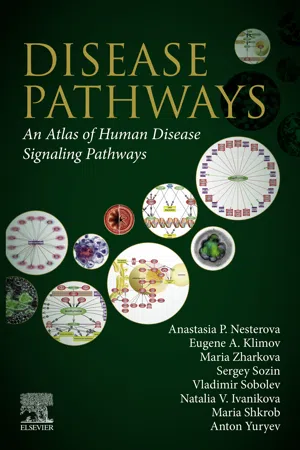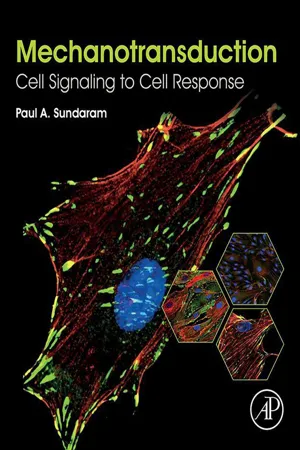Biological Sciences
Cellular Response
Cellular response refers to the reactions and changes that occur within a cell in response to internal or external stimuli. This can include processes such as cell signaling, gene expression, and the activation of specific cellular pathways. Cellular responses are essential for maintaining homeostasis, adapting to environmental changes, and coordinating the functions of different cells within an organism.
Written by Perlego with AI-assistance
Related key terms
4 Key excerpts on "Cellular Response"
- eBook - ePub
Disease Pathways
An Atlas of Human Disease Signaling Pathways
- Anastasia P. Nesterova, Anton Yuryev, Eugene A. Klimov, Maria Zharkova, Maria Shkrob, Natalia V. Ivanikova, Sergey Sozin, Vladimir Sobolev(Authors)
- 2019(Publication Date)
- Elsevier(Publisher)
Biological process —a series of events with a defined beginning and end, which affects essential functions of the live organism. (Examples are nerve transmission, gastric acid release, and brain development.)Cell process —a biological process that describes events on the cellular level that changes the cell’s behavior and functions. (Examples are apoptosis, chemotaxis, and phagocytosis.)Network —a database of interactions between molecules or/and biological processes without clear logic and causal relationships.Introduction to cell signaling
All living organisms share the ability to respond to external stimuli. Cells in a multicellular organism can change their status in response to various biochemical and electrochemical impulses, and they can communicate with each other using short- and long-distance signals. The ability to receive and transmit signals is vital for survival both at the cellular and the whole organism level. Cell signaling includes three major stages: signal perception (receiving of a signal), signal transduction (composed of a series of intracellular biochemical reactions), and Cellular Response.Signal reception
Various signals stimulate the cell—molecular, electrochemical, and mechanical, or physical signals all affect and elicit a Cellular Response. The most common means of cellular activation is via specific proteins on the cell surface or within the cell that can sense stimulatory biomolecules. Those molecules that react to stimulatory biomolecules are termed receptors. Signaling molecules that bind receptors—termed ligands —can be proteins, peptides, or other molecules. Ligand binding causes a conformational change in the receptor and transmission of the signal to other cellular proteins, which may or may not be bound to the receptor. Intercellular interactions are also conducted through various receptor-mediated signals. For instance, the regulation of interactions between neighboring cells can involve transmembrane notch receptors that are activated by the jagged (JAG1,2) or delta (DLL) ligands to trigger evolutionarily conserved signaling pathways important for the development of tissues and organs (Favarolo and López, 2018 ; Polychronidou et al., 2015 - eBook - ePub
- R. J. Collier, J. L. Collier, R. J. Collier, J. L. Collier(Authors)
- 2011(Publication Date)
- Wiley-Blackwell(Publisher)
On the whole organism/animal level, the cumulative sensing of being out of one's comfort zone is sensed in some brain functions that indicate that the climate is too hot, too cold, the animal is in ionic imbalance (thirsty), it's infected (fever, lethargy, malaise), and so on. The information for the appropriate behavioral response to attend to the insult is derived from various sensors that detect disturbances – pain receptors, pathogen recognition receptors (toll-like receptors, etc.), numerous nervous system-connected temperature and pressure sensors, as well as the general functioning of the neuroendocrine system. Since many of these whole animal aspects of stress control are well-characterized and summarized elsewhere (Epel, 2009; Denver, 2009; Caspi et al., 2010), this review will focus on Cellular Responses to stressors that form a powerful link between the environment and animal health.So how does a cell know that it is being challenged and stressed and furthermore needs to alter its biochemical routine to survive? Why is the Cellular Response to several different stress challenges apparently handled through just a few mechanistic processes common across these different challenges? At the cellular and subcellular level, this sensing is elegant in its simplicity and for the most part quite traceable evolutionarily to some of the most basic unicellular organisms. This sensing is so ancient that one can make a case for its origin being the separation of an internal environment from the external environment via a membrane (Monnard and Deamer, 2002) as a fundamental constituent of the definition of a living organism.Figure 8.3 is a composite of the major ways through which a cell can sense that its surrounding environment or the signals that impinge on it are innocuous or harmful. While complicated at first sight, the organization of the diagram is easily understood when the critical control points (numbered 1 through 7) are individually evaluated.Figure 8.3 Several factors common to many response pathways are critical control points (CCPs) in the cellular scheme of integrating environmental and immune stresses. CCPs 1 (plasma membrane), 3 (endoplasmic reticulum), and 5 (mitochondria) share the common feature of being membranes or membrane-bound structures and physical deformations of the lipid bilayer and associated proteins serve as evolutionarily conserved sensors of heat, red-ox state, pH, osmolarity, swelling, shear stress, etc. These deformations and physical protein activations set into motion cascades of processes, some common and some unique to the respective structure. Plasma membranes cluster interacting proteins (including cytokine and toll-like receptors, and an assortment of signal transduction proteins like JAK-2, AKT and MAP kinases) in caveolae (CCP 2) and with significant processing through NF–κB to the nucleus. In the ER, membrane sensing launches the unfolded protein response (UPR) initiated by release of nuclear transcription factors from BiP (CCP 4) to signal nuclear events through heat shock factor-1 and NF–κB. In the mitochondria, stress responses initiate Ca++ - eBook - ePub
Mechanotransduction
Cell Signaling to Cell Response
- Paul A. Sundaram(Author)
- 2020(Publication Date)
- Academic Press(Publisher)
The purpose of a signal in a cell is to accomplish some type of physiological function. Hence, the cell has to receive a signal, which then results in transduction within the cell and ultimately causes the cell to perform its function. In a nutshell, the overall mechanism in cell communication, including the initiation and response to a signal, consists of three distinct phases or steps: (1) signal reception, (2) signal transduction, and (3) signal response. The cell receives a signal through ligand binding with a receptor protein, which has both an extracellular portion to capture the signal and an intracellular or cytosol part, which transmits the signal to other intracellular proteins in a process called transduction. The signal is finally received by effector proteins, which accomplish the physiological function of the cell as the response. In what follows, a bird’s-eye view of the cell signaling process is provided without attempting to get into details of advanced biochemical reactions that occur in these processes, which are beyond the scope of this book. However, sufficient information is provided for the reader to grasp the fundamentals of cell signaling. Advanced students are directed to study this phenomenon in many research articles that are available, which deal specifically with this topic.2.2 Modes of cell communication
Cell signaling entails the transmission of information from one cell to another cell or a group of cells. Hence, cells must be able to communicate with each other to pass along this information onward. Faulty communication between cells results in deficiency in the transmission of information, which, in the human body, may lead to pathologies or disease. In a complex multicellular system such as the human body, it is imperative that there is effective communication between different cell groups for proper functioning of the system. It should be noted that there is a redundancy in the signaling, resulting in the same cell function, in case the primary signal is unable to accomplish its objective because of a deficiency in that signaling pathway. There is a plethora of communication pathways between cells and groups of cells. Cells respond to a variety of signals, which can be classified as chemical and mechanical stimuli. In a general sense, all cells are subjected to some kind of signaling, which elicits a physiological response. If we think about a simple sensation such as hunger, the initial signal comes from the pituitary gland, which in and of itself is triggered by a lack of energy production in the body. This signal is followed by the secretion of gastric juices in the stomach, which causes a “burning” sensation, creating an urge in us to consume food. The feedback from the energy generated by the breakdown of sugars from the food that was ingested results in the signal being shut off until more energy is needed. - eBook - ePub
A Pharmacology Primer
Techniques for More Effective and Strategic Drug Discovery
- Terry P. Kenakin(Author)
- 2022(Publication Date)
- Academic Press(Publisher)
Chapter 2: How different tissues process drug response
Abstract
Cellular signaling cascades are considered as a preface to a discussion of the nature of drug agonism (how drugs produce Cellular Response). The relationship between cell sensitivity and the intrinsic power of an agonist to induce response (quantified as “efficacy”) is used to explain the phenomena of full and partial agonisms. The application of various assay formats to the measurement of agonism is then considered.Keywords
Cellular signaling; Full agonists; Partial agonists; Pharmacological assays[Nature] can refuse to speak but she cannot give a wrong answer. — Dr. Charles Brenton Hugins (1966).We have to remember that what we observe is not nature in itself, but nature exposed to our method of questioning … —Werner Heisenberg (1901–76).2.1. The ‘eyes to see’: pharmacologic assays
If a drug possesses the molecular property of efficacy, then it produces a change in the receptor that may be detected by the cell. However, this can occur only if the stimulus is of sufficient strength and the cell has the amplification machinery necessary to convert the stimulus into an observable response. In keeping with the mandatory partnership of the sensitivity of the cell system and the intrinsic power of the agonist to produce a response, the cellular assay becomes a key component that controls the amount of information that can be gained from the experiment, in essence, the assay becomes the ‘eyes to see’ the change imparted to the cell by the drug. Cellular assays can be natural (and thus the sensitivity and components are set by Nature) or recombinant whereby the experimenter can manipulate the levels of response components and thus the sensitivity of the system. Fig. 2.1 shows some of the factors that play into the design of a pharmacologic assay whether as applied to binding studies (Chapter 4 ) or functional studies (Chapter 6 ). When building recombinant systems, the first option is the type of cell to be used. Different cells have different components and some of these may be critical to the response of a given agonist. A case in point is the response to the hormone amylin which interacts with a receptor formed by a dimer of the calcitonin receptor and the membrane protein RAMP3 (Receptor Activity modifying Protein 3). Thus, if a cell is not used that contains RAMP3, then transfection of calcitonin receptors will not constitute receptors for amylin and the assay will yield erroneous results (for further details see Fig. 5.3 ). Similarly, the relative stoichiometry of signaling components in a cell may affect observed bias of agonist response (for further details see Chapter 6 ). For complex binding curves whereby the binding complex is an amalgam of the receptor with other components (i.e., G-protein), differences in the complimentary protein can lead to differences in binding profiles. For instance, overexpression of receptor to the point where the G-protein components in a cell are insufficient to produce adequate levels of ternary complex, then complex binding curves will be produced (for further details see Fig. 4.19
Index pages curate the most relevant extracts from our library of academic textbooks. They’ve been created using an in-house natural language model (NLM), each adding context and meaning to key research topics.



